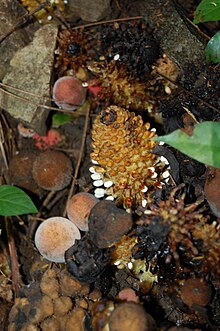
Leptospermum is a genus of shrubs and small trees in the myrtle family Myrtaceae commonly known as tea trees, although this name is sometimes also used for some species of Melaleuca. Most species are endemic to Australia, with the greatest diversity in the south of the continent, but some are native to other parts of the world, including New Zealand and Southeast Asia. Leptospermums all have five conspicuous petals and five groups of stamens which alternate with the petals. There is a single style in the centre of the flower and the fruit is a woody capsule.

The Amami rabbit, or Amami no-kuro-usagi, also known as the Ryukyu rabbit is a dark-furred rabbit which is only found in Amami Ōshima and Toku-no-Shima, two small islands between southern Kyūshū and Okinawa in Kagoshima Prefecture in Japan. Often called a living fossil, the Amami rabbit is a living remnant of ancient rabbits that once lived on the Asian mainland, where they died out, remaining only on the two small Japanese islands where they live today.

Artocarpus is a genus of approximately 60 trees and shrubs of Southeast Asian and Pacific origin, belonging to the mulberry family, Moraceae. Most species of Artocarpus are restricted to Southeast Asia; a few cultivated species are more widely distributed, especially A. altilis (breadfruit) and A. heterophyllus (jackfruit), which are cultivated throughout the tropics.

Aleurites is a small genus of arborescent flowering plants in the Euphorbiaceae, first described as a genus in 1776. It is native to China, the Indian Subcontinent, Southeast Asia, Papuasia, and Queensland. It is also reportedly naturalized on various islands as well as scattered locations in Africa, South America, and Florida.

Elaeocarpus is a genus of nearly five hundred species of flowering plants in the family Elaeocarpaceae native to the Western Indian Ocean, Tropical and Subtropical Asia, and the Pacific. Plants in the genus Elaeocarpus are trees or shrubs with simple leaves, flowers with four or five petals usually, and usually blue fruit.

Schefflera is a genus of flowering plants in the family Araliaceae with 13 species native to New Zealand and some Pacific islands.

Acronychia is a genus of about fifty species of plants in the rue family Rutaceae. The leaves are simple or pinnate, and the flowers bisexual with four sepals, four petals and eight stamens. They have a broad distribution including in India, Malesia, Australia and the islands of the western Pacific Ocean. About twenty species are endemic to Australia.

Banksia goodii, commonly known as Good's banksia, is a species of prostrate shrub that is endemic to a small area in the south-west of Western Australia. It has densely hairy stems, wavy, oblong to egg-shaped leaves with irregularly serrated margins, rusty-brown flowers and hairy fruit. It grows in low forest and woodland near Albany and is listed as "endangered".

Ripogonum is a genus of flowering plants confined to eastern Australia, New Zealand, and New Guinea. Until recently this genus was included in the family Smilacaceae, and earlier in the family Liliaceae, but it has now been separated as its own family Ripogonaceae.

Banksia baxteri, commonly known as Baxter's banksia or bird's nest banksia, is a species of shrub that is endemic to Western Australia. It has greyish brown bark, hairy stems, deeply serrated leaves with triangular lobes and lemon-yellow flowers in an oval flower spike that grows on the end of branches.

Barringtonia is a genus of flowering plants in the family Lecythidaceae first described as a genus with this name in 1775. It is native to Africa, southern Asia, Australia, and various islands of the Pacific and Indian Oceans. The genus name commemorates Daines Barrington.

Dichondra repens, commonly known as kidney weed, Mercury Bay weed, tom thumb, or yilibili in the Dharawal language, is a species of flowering plant in the family Convolvulaceae and is native to Australia, New Zealand, and the Indian Ocean islands, Mauritius, Réunion and Rodrigues. It is a perennial, herb with kidney-shaped to round leaves and small, greenish-yellow, star-shaped flowers.

Acronychia laevis, commonly known as hard aspen, glossy acronychia or northern white lilly pilly, is a species of shrub or small tree in the citrus family, and is endemic to eastern Australia. It has simple, elliptical to egg-shaped leaves, groups of creamy white flowers and fleshy, mitre-shaped to spherical fruit.

Codia is a genus of trees and shrubs in the family Cunoniaceae. The genus is endemic to New Caledonia in the Pacific and contains 15 species. The leaves are opposite or whorled, simple, and the margin usually entire. The flowers are arranged in capitula. the ovary is inferior. The fruit is indehiscent and is covered with woolly hairs.

Decaspermum is a genus of the botanical family Myrtaceae, first described as a genus in 1776. It is native to China, Southeast Asia, Queensland, and various islands of the Pacific Ocean.

Balanophora fungosa, sometimes known as fungus root is a flowering plant in the family Balanophoraceae and occurs in South Asia, Southeast Asia, Australia and some Pacific Islands. It is an obligate parasite growing on the roots of rainforest trees. The flowering structure is shaped like a puffball but in fact consists of a globe covered with thousands of tiny female flowers. The globe is surrounded at its base by a much smaller number of male flowers. In flower, the plant emits an odour resembling that of mice.
Miquelia is a genus of plants in the family Icacinaceae found in tropical India, Southeast Asia, and the Philippines.

Zanthoxylum pinnatum, commonly known as yellow wood, is a species of flowering plant of the family Rutaceae native to Lord Howe and Norfolk Islands. It is a tree with pinnate leaves, white male and female flowers arranged in groups in leaf axils, and spherical, purple follicles containing a single black seed.

Sapindoideae is a subfamily of flowering plants in the soapberry family, Sapindaceae. It includes a number of fruit trees, including lychees, longans, rambutans, and quenepas.


















